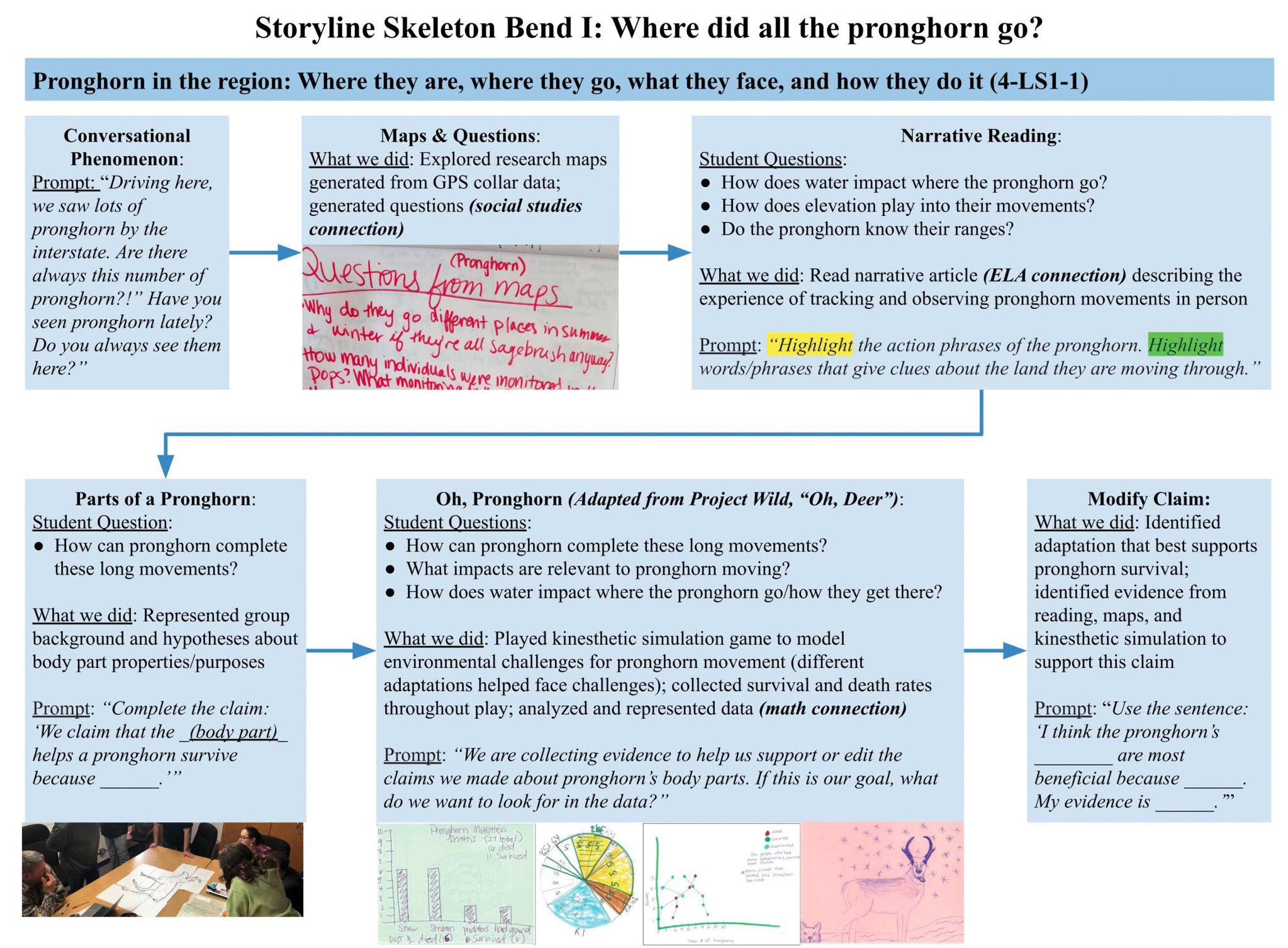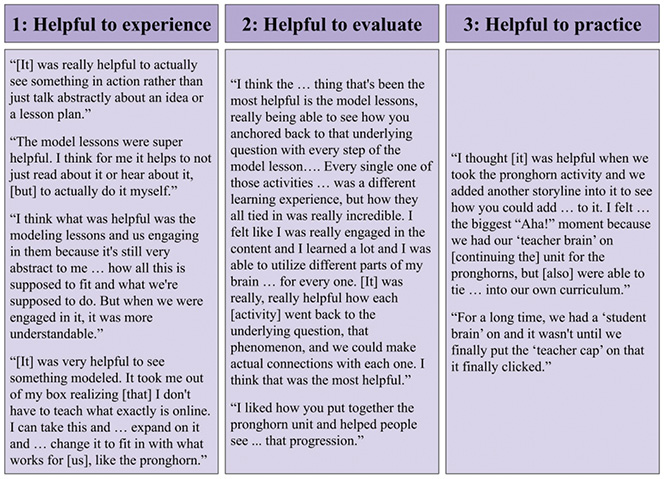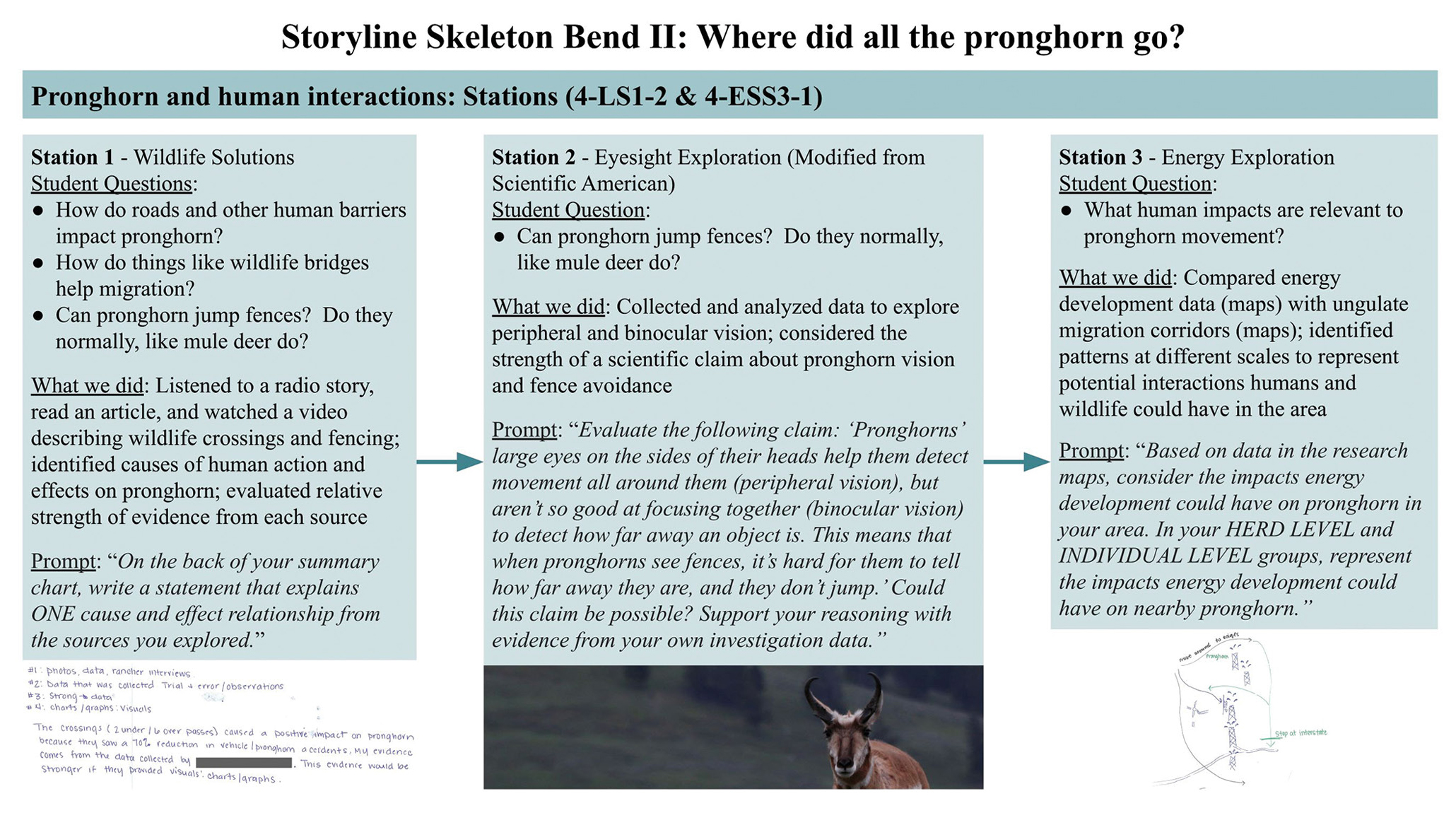Start with phenomena
Phenomenon-Based Professional Development
Shifting Perspectives Between Teacher and Learner to Build Understanding of Complex Science Instruction
Science and Children—March/April 2021 (Volume 58, Issue 4)
By Clare Gunshenan, Martha Inouye, Ana Houseal, and Tracy Jacobs
“How [the activities] all tied in was really incredible … I felt like I was really engaged in the content and I learned a lot and I was able to utilize different parts of my brain,” one fourth-grade teacher reflected after participating in a science professional development (PD) workshop series. The aforementioned activities wove together to help explain a complex and compelling phenomenon, creating a storyline that provided a coherent structure to organize her learning (Reiser 2014). Modeling this instruction for this teacher and her colleagues was paramount to building their experiences with phenomenon-based teaching—an approach few had experienced.
Now imagine your students saying something similar to you about their learning. We build science PD experiences for teachers in sustained, yearlong workshop progressions so that they can design similarly powerful learning experiences for their students. Over three workshops, one group of teachers in our PD engaged as both learners and planners in a phenomenon-based storyline that supported Next Generation Science Standards (NGSS) aligned instruction. In this article, we share how model lessons spaced throughout the year, connected by a single anchoring phenomenon, provided opportunities for teachers to build schema for complex science learning as they shifted between “learner hats” and “teacher hats.” Descriptions of our workshop sessions include instructional intentions, instructional strategies, overviews of what teachers did and learned, and our PD workshop design considerations.
Pronghorn: A Relevant Learning Context
Phenomena constitute observable events that enable students to ask and investigate questions and then use evidence they gathered to explain the phenomenon (Reiser 2014). In our rural western state, wildlife plays a large role in daily life for teachers and their students—encountering animals while driving, seeing them around town, hunting them, and celebrating them as school mascots. For these reasons, our science PD team chose a familiar ungulate, the pronghorn (colloquially “antelope”), and its treacherous semi-annual migrations as a place-relevant phenomenon with a group of upper elementary teachers.
First, we shared a simple observation: “Driving here, we saw lots of pronghorn by the interstate. Are there always this many pronghorn?!” Teachers immediately started to share personal experiences to explain to us what was happening, why the animals move, and where they go.
Since you can never assume that all of your learners have had similar experiences outside of the classroom, we then provided a few other entry points for teachers to access the phenomenon. These included maps, a narrative, and photographs, all depicting pronghorn movements. This approach honored teachers’ personal experiences and used multiple modalities to make the phenomenon accessible, regardless of whether they brought personal experiences to the table. From these simple observations of animal movement, our anchoring phenomenon emerged: what it takes for pronghorn to make and survive long migrations. The community’s deep connection to the animals made this phenomenon a natural, relevant context for teachers to both participate as learners in related investigations and think about how to use phenomena (see a full discussion of what makes a good phenomenon and how they can be used in Inouye, Houseal, and Gunshenan 2020).
Bends in the Storyline
Teachers built their understanding of the pronghorn’s journey by connecting multiple bends in the phenomenon storyline (Figure 1). Whether they were learning about behavioral and physical adaptations, impacts of human development, human-wildlife interactions, or environmental conditions, each activity connected back to the pronghorn’s survival during migration. One teacher noted how effective it was to experience this as a learner: “[H]ow each [activity] went back to the underlying question, that phenomenon, and … we could make actual connections with each one … I think that was the most helpful.”

Pronghorn storyline skeleton.
Workshop One: Pronghorn in the Region (4-LS1-1)
We know that high-quality PD engages teachers as learners in models of effective instruction (Loucks-Horsley et al. 2003; Klein and Riordan 2011), and phenomenon-based, storyline-driven, three-dimensional instruction is complex and new to teachers. Therefore, in the first workshop, teachers participated primarily as learners (Figure 2). It was not until the end of this sequence that they switched perspectives from learner to teacher, so that they could build schema for phenomenon-based instruction.

Anchoring phenomenon.
We designed the workshop investigations to explore the pronghorn phenomenon through the NGSS three dimensions of science learning: the science and engineering practices (SEPs), crosscutting concepts (CCCs), and disciplinary core ideas (DCIs) (NRC 2012). For instance, after sharing their personal experiences of pronghorn through a think-pair-share, teachers felt motivated to see how these experiences matched documented temporal and spatial patterns (CCC: patterns) and narrative descriptions of pronghorn migration (SEP: obtaining, evaluating, and communicating information). They explored these resources by independently annotating the narrative (opportunity to target CCSS.ELA-LITERACY.RI strand), observing patterns in maps in small groups, and engaging in group discussions to summarize their findings and compare the resources (opportunity to target CCSS.ELA-LITERACY.SL strand). The (dis)connections between the sources and teachers’ personal experiences provided a purpose to engage in other activities to understand pronghorn physical and behavioral adaptations (DCI: LS1.A: structure and function) in conjunction with CCCs and SEPs. The model lesson ended after teacher groups created representations of the data they collected and analyzed during “Oh, Pronghorn” (see Figure 2—opportunity to reinforce CCSS.MATH.PRACTICE.MP3 and CCSS.MATH.PRACTICE.MP4).
For learners to do science, they need practice engaging in the three dimensions, so it was our instructional intention for teachers to use and combine the three dimensions as they made sense of the overarching phenomenon. We reserved explicit discussion of these dimensions for the following workshop, so as to immerse them in the learning process before asking them to identify how their learning was guided by three-dimensional instruction.
When debriefing the experience, most teachers reported a mix of feelings: engagement, interest, frustration, and curiosity. They noted that their familiarity with pronghorn helped them to feel a degree of ownership, and as a result they were more engaged and motivated for the investigations. Those who shared frustration talked about feeling annoyed at times that facilitators did not provide immediate or “right” answers. Teachers easily connected their feelings to those of their students and reflected that they learned a lot despite the initial frustration. They found value in not being told the answer because it put the intellectual burden on them (the learners) to investigate the phenomenon.
On the heels of their model lesson debrief, we supported teachers to apply their generalizations to planning components of a phenomenon-based storyline they could use in their own instruction. This structure included workshop time to plan with their peers, small-group opportunities for facilitator feedback, facilitated peer feedback, and consistent connections to teachers’ own contexts. When reflecting, many teachers emphasized that this application step was critical to their understanding and ability to use phenomena (Figure 3, column 1). Participating in, debriefing, and applying ideas from model lessons had teachers noting things like, “my brain has so much when I leave here,” because phenomena, storylines, and three-dimensional learning are all relatively new. We have worked to alleviate this burden by modeling all of these elements but delaying some of the debriefs. We waited until Workshop 2 to more explicitly draw teacher attention to the storyline and three-dimensional learning they experienced. Instead, we focused them on how they engaged with phenomena.
Phenomena serve as more than just flashy hooks to garner initial interest; they provide a context and purpose for constructing and critiquing science understanding (Inouye, Houseal, and Gunshenan 2020). Teachers made structural generalizations about how we first solicited their experiences with and questions about the pronghorn phenomenon and that investigations seemed to address their questions (see Figure 2). This opened the door for us to talk about student-driven yet teacher-guided instruction: we could anticipate learner questions because of how we introduced the phenomenon. By carefully selecting our materials and prompts, we guided the types of questions teachers asked (see prompt for narrative reading in Figure 2). While we could not drastically alter investigations to address questions we didn’t anticipate, we could make explicit connections to some questions, provide space to self-assess learning, and ask teachers to connect their learning to the central phenomenon. In sum, this first workshop included model lessons with connections to the phenomenon, conversations about instructional strategies and planning approaches, and time for teachers to apply ideas to their own planning.
Workshop Two: Pronghorn and Human Interactions (4-LS1-2 & 4-ESS3-1)
Teachers invested significant thought in their initial questions, so we leveraged their ownership over unanswered questions to ground subsequent learning. In the second workshop, teachers began by wearing their “learner hats” as they collectively reviewed a summary chart (see Figure 4) of what they did in Workshop 1. Then, they donned their “teacher hats” to identify what SEPs and CCCs they had engaged in as learners. Through table discussions, teachers generated evidence for their selections.

Teacher comments on phenomena.

Summary chart.
We designed the remainder of the workshop to have teachers continue transitioning between hats so as to experience and practice evaluating activities for three-dimensional alignment. In small groups, teachers rotated between three stations (Figure 5), each of which investigated connections between pronghorn adaptations and human impacts, and each of which addressed remaining learner-generated questions from the first workshop. As teachers rotated through the stations, they filled in a summary chart to summarize what they did and learned. At the end of each investigation, they put on their “teacher hat” to identify how the station had addressed SEPs and CCCs. Teachers consistently noted that explicit framing in activities helped them recognize how and when they engaged various dimensions.

Stations.
After all three stations, we prompted teachers to analyze their completed summary charts for connections between stations and the pronghorn phenomenon. Then, groups reached consensus by having one group share one connection, giving time for others to respond. The next group then added on until all connections were made and agreed upon (opportunity to foster CCSS.ELA-LITERACY key ideas and details strands). We did this to help teachers recognize how a storyline helps learners create coherence between investigations and to provide an example of leading such a discussion to synthesize learning. Teachers shared that this analysis helped them notice that their questions from the first workshop were prominently featured in the investigations. We emphasized this idea of leveraging learner questions to direct students toward a “bend” in a storyline. This built teacher capacity to think of planning their own coherent-to-students storylines.
Workshop 2 exemplifies the gradual release model we used to support teachers’ instructional efficacy. The first workshop helped teachers build schema about phenomena. The second continued to build schema through an ongoing storyline that helped learners access the complexities of the phenomenon, while also building their understanding of how the three dimensions had been embedded in the instruction. They experienced three-dimensional storylines as learners and explicitly built schema about these ideas when they put on their “teacher hat.” By “releasing” teachers to think about how we addressed the three dimensions and built coherence between investigations, they developed skills for creating similar instruction, which they applied during collaborative, feedback-oriented planning time. Several teachers reported that emphasizing coherence is what helped them make sense of this model of science learning (Figure 3, column 2). In the third and final workshop, teachers would be released even more.
Workshop Three: Energy Interactions (4-ESS3-1)
To help teachers solidify their own process for developing storyline-driven, phenomenon-based, three-dimensional lessons, we challenged them to design the next bend in the progression. To focus this task, we provided a current event (investigative phenomenon), a related learner-generated question, a group of relevant grade-level standards, and a series of local resources (see Figure 6). After reviewing the storyline bends from the first two workshops, teachers worked in small groups to consider how they might develop an investigation to continue addressing the pronghorn phenomenon. For several teachers, planning themselves helped them make sense of this complex instructional approach (Figure 3, column 3).

Culminating project.
In this planning process, teachers noted the importance of examining their standards first. Once they had a good sense of what their standards required, they could practice integrating learner questions, the three dimensions, and investigations into the ongoing storyline. By sharing their bends with one another to offer and solicit feedback, teachers saw that a single phenomenon provided many opportunities for different cross-curricular connections, depending on their approach.
Recommendations for NGSS-aligned PD
Many of the PD structures and strategies from this pronghorn storyline both modeled and helped teachers make sense of complex science instruction. Most centrally, we modeled NGSS-aligned instruction that went beyond a few sample activities that connected strategies to content (Borko, Jacobs, and Koellner 2010). Instead, the learning activities required teachers to engage in integrated three-dimensional, phenomenon-based, storyline-driven learning and provided space to consider how to replicate these structures in their own classroom (see Figure 2). Teachers’ growth across the yearlong progression of workshops demonstrates the value in using a single storyline to practice this transfer.
The combination of learner (experiencing) and teacher (evaluating and planning) hats promoted teachers’ collective deepening of their understanding (see Figure 3). As they moved back and forth between learner and teacher perspectives, teachers made generalizations at multiple scales: how their instruction is similar to and different from the model, how the learning sequence accessed their interest, and how they could use pieces of the workshop in their classrooms (Klein and Riordan 2011). The generalizations teachers made in each workshop have been instrumental in their continued team planning within and across schools. Several reported that these generalizations have helped them to make similar phenomenon-based, storyline-based, NGSS-aligned shifts in other parts of their curriculum. This particular group of teachers will engage in another year of science PD where they will continue reflecting on the changes they have made, the shifts they would like to continue making, and the community supports that will help them to actualize these changes. They are well on their way to shifting their instruction, while also recognizing that this is a multiyear process in which progress is made one step at a time.
This ongoing storyline model with gradual release of teacher planning afforded valuable opportunities for teachers to experience how it looks and feels to organize learning around a phenomenon. Further, many of the participating teachers requested storyline materials to adapt and use in their own classrooms. We have worked with these teachers to help them identify how they might modify the investigations to better suit their needs, make more personal connections to their classrooms, and reinforce interdisciplinary connections. For instance, teachers might extend this phenomenon to have students transfer their learning to other migrations (e.g., human, bird, insect) through stories from their communities, other communities, and students’ own experiences. This sort of extension builds opportunities to center inclusivity, multicultural connections, and ELA connections in students’ science learning, and leverages meaningful contexts to help students transfer their learning. The instructional and design strategies embedded in the pronghorn storyline and the space for teachers to reflect on applications to their own classrooms provided invaluable experiences; we encourage other facilitators to consider these ideas in their own work with teachers. ●
Clare Gunshenan (cgunshen@uwyo.edu) is an outreach science educator, Martha Inouye is a research scientist, Ana Houseal is an associate professor, and Tracy Jacobs is a graduate student, all in the Science & Mathematics Teaching Center at the University of Wyoming in Laramie, Wyoming.
Phenomena Professional Learning old Teacher Preparation


